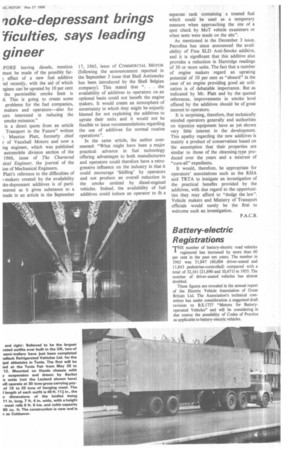loke-depressant brings ficulties, says leading gin eer
Page 79

If you've noticed an error in this article please click here to report it so we can fix it.
FORE leaving diesels, mention must be made of the possibly far; effect of a new fuel additive .ed recently, with the aid of which igines can be uprated by 10 per cent
the permissible smoke limit is d. This is going to create some problems for the fuel companies, makers and operators—also for (ers interested in reducing the smoke nuisance."
is a direct quote from an article Transport in the Future" written Maurice Platt, formerly chief r of Vauxhall Motors and now a Lng engineer, which was published automobile division section of the 1966, issue of The Chartered tical Engineer, the journal of the ion of Mechanical Engineers.
Platt's reference to the difficulties of /-makers created by the availability )ke-depressant additives is of partinterest as it gives substance to a made in an article in the September
17, 1965, issue of COMMERCIAL MOTOR (following the announcement reported in the September 3 issue that Shell Antismoke has been introduced by the Shell Belgian
company). This stated that ". . the availability of additives to operators on an optional basis could not benefit the engine makers. It would create an atmosphere of uncertainty in which they might be unjustly blamed for not exploiting the additives to uprate their units and it would not be feasible to issue recommendations regarding the use of additives for normal routine operations".
In the same article, the author commented: "What might have been a major practical advance in fuel technology offering advantages to both manufacturers and operators could therefore have a retrogressive influence on the industry in that it could encourage 'fiddling' by operators and not produce an overall reduction in the smoke emitted by diesel-engined vehicles. Indeed, the availability of fuel additives could induce an operator to fit a
separate tank containing a treated fuel which could be used as a temporary measure when approaching the site of a spot check by MoT vehicle examiners or when tests were made on the site-.
As mentioned in the December 3 issue, Petrofina has since announced the availability of Fina SLD Anti-Smoke additive. and it is significant that this additive also provides a reduction in Hartridge readings of 30 or more units. The fact that a number of engine makers regard an uprating potential of 10 per cent as "absurd" in the case of an engine providing good air utilization is of debatable importance. But as indicated by Mr. Platt and by the quoted references, improvements in smoke level offered by the additives should be of great interest to operators.
It is surprising, therefore, that technically minded operators generally and authorities on injection equipment have as yet shown very little interest in the development. This apathy regarding the new additives is mainly a product of conservatism based on the assumption that their properties are similar to those of the cleansing-type produced over the years and a mistrust of "cure-all" expedients.
It would, therefore, be appropriate for operators' associations such as the RHA and TRTA to instigate an investigation of the practical benefits provided by the additives, with due regard to the opportunities they may afford to "dodge the law". Vehicle makers and Ministry of Transport officials would surely be the first to welcome such an investigation.




































































































































































































































































